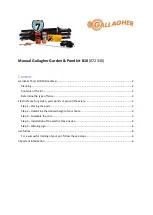
28
EN
3 .2 General installations notes
The requirements of the standard EN ISO 14119 must be taken into account during installation.
Precautions during installation
Observe the following instructions to prevent injuries of persons or damages
to the device.
The mounting holes allow mounting using M6 Torx pan-head screws with countersunk pin
(safety screws) screws with a max. tightening torque of 6 Nm.
Screws made of non-ferromagnetic material (e.g. brass) must be used. The mounting position
is arbitrary. To counteract excessive heat generation, the safety sensor must be mounted
on a heat-conducting base. However, the safety sensor and actuator must be mounted in
parallel opposite each other.
Heat note
If the temperature exceeds 60°C due to ambient conditions and self-heating,
the supplied sticker "Warning of hot surface" must be attached.
The safety sensor may only be installed in the assured operating distances. The safety sensor
and the actuator must be installed to the protective device by suitable measures (use of
one-way screws, gluing, drilling of screw heads, pinning) and secured against displacement.
In order to avoid system-related influence and reduction of the operating distances, please
observe the following instructions:
• Metal parts near the sensor can change the operating distance
• Keep metal chips away
• Minimum distance between two process locks: 150 mm
Influence
Be aware that magnetic fields can delete data carriers and impact or destroy
electronic or mechanic components, such as cardiac pacemakers.
During direct contact to magnetic materials and systems, allergic reactions
can arise (e.g. against ceramic and metallic materials as well as zinc, nickel
and plastics).
The process lock with safety function may only be mounted on flat surfaces.
• The connecting cable of the process lock must be installed in such a way that it is
protected against mechanical damage.
• During installation, also take into account the requirements of EN 60204-1, especially
with regard to suitable installation. It is recommended to install the sensor connecting
cable concealed.
3 .3 Alignment of the HOLDX and anchor plate with lateral markings
Fig. 3: Line markers for aligning the HOLDX RL
Before the magnet is switched on for the first time, the door must be closed and the anchor
plate with the built-in RFID sensor must be aligned as shown in Fig. 3! After switching on, a
magnetic flux measurement is automatically carried out for approx. 10 s and the measurement
data is stored completely in the HOLDX. This is necessary for magnetic force monitoring.
During magnetic flux measurement, the blue and green LEDs flash five times. During this
time the anchor plate must not be moved or separated. If this should happen, the teach-in
process is restarted at the next magnet activation.
The HOLDX stores magnetic flux measurements and the time stamp, as well as the anchor
plate ID as soon as an anchor plate is detected. For special applications where several
different anchor plates must be paired with a HOLDX process lock, the HOLDX can store
up to 16 different anchor plates.
When the anchor plate is correctly aligned with the HOLDX process lock, the green LED is
permanently lit (see Section 6.1 - LED display, flashing codes)
See also Section 7.2 - Teach-in process of the version "Individual, reteachable".
3 .4 Adjustment
The specified operating distances, see Section 2.8 – Technical data, only apply for installation
on non-metallic material if the safety sensor and actuator are mounted parallel to each other.
Other arrangements may lead to different operating distances.
















































